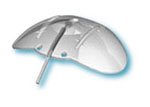Glaucoma is a group of eye conditions that cause damage to the optic nerve and lead to irreversible vision loss. It is typically characterized by increased intraocular pressure (IOP) which occurs when the fluid inside the eye, known as aqueous humor, does not drain properly.
There are different types of glaucoma, but all of them can lead to vision loss if left untreated. One of the most common treatments for glaucoma is to lower the IOP to prevent further damage to the optic nerve. This can be achieved through a variety of methods, including medications, laser surgery, and traditional surgery.
In some cases, however, these treatments are not effective in controlling IOP. This is where glaucoma valves or glaucoma drainage devices come in. These devices are small implants that are designed to help regulate the flow of fluid out of the eye, lowering IOP and preventing damage to the optic nerve.
There are several types of glaucoma valves, but they all work in a similar way. The valve is typically a small tube made of biocompatible materials like silicone or polypropylene. It is implanted in the eye during a surgical procedure and is positioned so that it allows fluid to drain out of the eye and into a reservoir or space beneath the conjunctiva, the thin membrane that covers the white part of the eye.
Once the valve is in place, it regulates the flow of fluid from the eye, keeping the pressure in the eye at a safe level. This helps to prevent damage to the optic nerve and maintain healthy vision. Glaucoma valves are typically used in cases where other treatments, such as eye drops or laser surgery, have not been effective in controlling intraocular pressure.
There are several advantages of using glaucoma valves over other treatment options. Firstly, they are more effective in controlling IOP in patients with advanced glaucoma. Secondly, they do not require as much follow-up care as other treatments, as they are designed to be long-lasting. Additionally, glaucoma valves can be used in patients who have had previous eye surgeries, as they are less likely to cause scarring or other complications.
However, like any surgical procedure, there are also risks associated with glaucoma valves. The most common complication is infection, which can occur in up to 10% of patients who undergo the procedure. Other risks include bleeding, inflammation, and device failure. It is important to discuss the risks and benefits of glaucoma valves with your eye doctor before deciding on a treatment plan.
In conclusion, glaucoma valves or glaucoma drainage devices are a valuable treatment option for patients with glaucoma who have not responded to other treatments. They work by regulating the flow of fluid out of the eye, helping to control intraocular pressure and prevent damage to the optic nerve. While there are risks associated with the procedure, glaucoma valves are generally effective and long-lasting, providing a viable treatment option for patients with advanced glaucoma.
At The Eye Center- Dr. Mahnaz Naveed Shah & Associates our team of eight ophthalmology subspecialists/ eye specialists, eye surgeons who are considered amongst the very best eye specialists in Karachi and in Pakistan, have the diagnostic and treatment capabilities to treat from the simplest to the most complex patients. We work hard to provide our patients with the best possible medical and surgical eye care, in a state of the art purpose built eye care facility. We offer the entire array of medical, laser and surgical treatments to help provide patients the best possible care in the most efficient, safe and ethical manner.
If you need an appointment, please contact us at 03041119544 during our working hours or leave us a WhatsApp message at +923028291799 and someone will connect with you. Walk-in appointments are also available for emergencies. We can also be reached through our web portal on www.surgicaleyecenter.org

